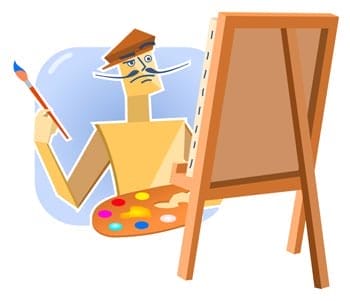
6 Steps to a Winning Artist’s Brand That Sells
In the competitive world of art, standing out and making a lasting impression is crucial for success. A strong brand and identity not only help you differentiate yourself from other artists but also allow you to connect with your target audience on a deeper level.
In this guide, we will explore how to brand yourself as an artist. We look at the importance of branding and provide practical steps to help you develop a unique and memorable brand and identity that resonates with potential buyers, collectors, and clients.
We will cover various aspects of developing an artist’s brand and identity, providing you with valuable insights and actionable tips to grow your customer base and boost your art sales. So, let’s dive into the fascinating world of branding and discover how you can elevate your artistic career to new heights.
What is an Artist Brand Identity?
An effective artist’s brand and identity encompass everything from your artistic niche and visual presentation to your website, social media presence and personal narrative. By crafting a cohesive and compelling brand, you can convey the essence of your work, your values, and your artistic vision to your audience, making it easier for them to understand, appreciate, and ultimately invest in your art.
The benefits of Establishing a Brand Identity
STEP 1: Defining Your Artistic Niche

An important first step in building a strong brand identity for yourself is to define your artistic niche.
By honing in on a specific style, subject matter, or medium, you’ll establish a unique position within the art world and attract a dedicated audience that appreciates and connects with your creative vision.
Let’s explore the importance of defining your artistic niche and how it can pave the way for your success as an artist.
Finding Your Unique Selling Proposition
Your unique selling proposition (USP) is what sets you apart from other artists in the market. It’s the combination of your artistic style, techniques, themes, and personal story that makes your work distinctive and appealing to potential buyers. To define your USP, consider the following aspects:
- Your artistic style: Are you a minimalist, abstract, or figurative artist? What is your preferred medium, and how does it contribute to your unique style?
- Techniques and processes: What techniques or processes do you use to create your art? Are there any unique elements or methods that distinguish your work from others?
- Themes and concepts: What themes, emotions, or concepts do you explore in your art? How do these themes resonate with your audience?
- Personal story: How does your background, experiences, or beliefs influence your art? How can you weave your personal story into your artistic narrative?
Identifying Your Target Audience

Understanding your target audience is essential for tailoring your marketing efforts and connecting with potential buyers who appreciate and value your art. To identify your target audience, consider factors such as:
- Demographics: What age, gender, income level, education, and location best describe your ideal buyers?
- Psychographics: What values, interests, and lifestyles do your ideal buyers share? How do these factors align with your art and your USP?
- Art preferences: What types of art, themes, or styles are your ideal buyers most likely to appreciate or collect?
Once you have a clear picture of your target audience, you can develop marketing strategies that resonate with their preferences and needs.
Key takeaway: By defining your artistic niche and understanding your unique selling proposition and target audience, you can create a focused and effective marketing strategy that appeals to the right buyers and helps you grow your art business. Leveraging the available resources and refining your niche will set you on the path to success in the competitive art world.
STEP 2: Developing Your Visual Identity

The next step is to create a distinct and consistent visual identity, as this will set the foundation for your brand and helps you stand out in a competitive market.
There are three essential components of your visual identity: logo and typography, color palette, and consistency in style and presentation.
1. Logo and Typography
A well-designed logo is an important aspect of your visual identity, as it creates a memorable impression and sets the tone for your brand. Your logo should reflect your artistic style and be easily recognizable across various platforms and promotional materials.
When selecting typography for your brand, consider fonts that complement your logo and resonate with your artistic vision. Consistent use of typography helps establish a cohesive look and feel for your brand.
For logo design inspiration and creation, you can use online tools like Canva or Adobe Spark. For a wide range of free fonts, check out Google Fonts and Font Squirrel.
2. Color Palette
Your brand’s color palette plays a significant role in defining your visual identity. Colors have the power to evoke emotions and create associations, so it’s crucial to choose a palette that represents your artistic vision and connects with your target audience.
When selecting colors, consider their psychological impact and the message you want to convey through your brand. For instance, warm colors like red, orange, and yellow evoke energy and passion, while cool colors like blue, green, and purple create a sense of calm and serenity.
To create a cohesive color palette, use online tools like Coolors.co or Adobe Color. These platforms allow you to generate and save color schemes, ensuring consistency across your branding materials.
3. Consistency in Style and Presentation
Maintaining a consistent style and presentation across all platforms and materials is essential for establishing a strong visual identity. This includes using the same logo, typography, and color palette on your website, social media profiles, and promotional materials, such as business cards, brochures, and exhibition banners.
Additionally, ensure that your artwork is presented consistently in your portfolio, with uniform image sizes, framing or borders, and descriptive captions. This attention to detail creates a polished and professional look, reinforcing your brand identity.
Key takeaway: A well-defined visual identity is essential for artists to create a lasting impression and distinguish themselves in the competitive art world. By focusing on logo and typography, color palette, and consistency in style and presentation, you can establish a strong brand identity that resonates with your audience and sets the foundation for a successful art career.
STEP 3: Crafting Your Artist’s Statement

An artist’s statement is a crucial component of your brand identity, as it helps communicate your artistic vision and connects with your audience on a deeper level. A well-crafted artist’s statement makes your work relatable and engaging, allowing potential buyers and collectors to understand the motivation and inspiration behind your creations.
Communicating Your Artistic Vision
To effectively communicate your artistic vision in your statement, consider the following:
- Describe your creative process and the techniques you use in your work.
- Explain the themes, concepts, or emotions that drive your art.
- Share any personal experiences or stories that have influenced your artistic journey.
By incorporating these elements into your artist’s statement, you provide your audience with valuable insight into your creative world, helping them form a connection with your art.
Making It Relatable and Engaging
To make your artist’s statement relatable and engaging, focus on:
- Writing in a clear and concise manner, avoiding jargon or overly complex language.
- Sharing personal anecdotes or experiences that resonate with your audience.
- Demonstrating your passion for your work and highlighting the unique aspects of your artistic approach.
Tip: Start by writing down your thoughts, inspirations, and creative process in bullet points. This exercise will help you identify the key elements of your artistic vision, making it easier to craft a cohesive and engaging artist’s statement.
By following these guidelines and making use of the available resources, you can craft an artist’s statement that effectively communicates your artistic vision and makes your work relatable and engaging to your audience. This, in turn, will strengthen your brand identity and help you establish a successful career in the art world.
Read more in our post How to Write an Artist’s Statement.
STEP 4: Building Your Personal Brand
Building a personal brand as an artist is essential for connecting with your audience and establishing a unique presence in the art world. By developing a personal narrative, showcasing your personality and values, and engaging in networking and collaboration, you can create a strong and memorable personal brand.
Developing a Personal Narrative
Creating a personal narrative helps convey the story behind your work and allows potential buyers and collectors to connect with you on a deeper level. To develop your personal narrative, consider the following:
- Reflect on your artistic journey, including milestones and challenges you have overcome.
- Identify the core themes and concepts that drive your work.
- Share personal anecdotes or experiences that have shaped your artistic perspective.
Showcasing Your Personality and Values
Your personality and values play a crucial role in defining your personal brand. By showcasing these elements, you can create a unique and authentic connection with your audience. Here are some ways to showcase your personality and values:
- Use your artist statement and personal narrative to communicate your artistic vision and passion.
- Share behind-the-scenes content, such as work-in-progress shots or studio tours, to give your audience a glimpse into your creative process.
- Engage with your followers on social media by responding to comments and messages, and participating in conversations related to your work or the art world in general.
Networking and Collaboration
Networking and collaboration are essential for building relationships, expanding your reach, and growing your career. These activities also contribute to your personal brand by showcasing your connections, expertise, and willingness to engage with the art community. Some ways to network and collaborate include:
- Participating in art communities and forums, such as ArtStation or DeviantArt.
- Collaborating with other artists, galleries, or organizations on joint projects or exhibitions.
- Attending art fairs, exhibitions, and events to connect with fellow artists, collectors, and industry professionals.
By focusing on these aspects of your personal brand, you can create a strong and memorable identity that resonates with your audience and sets you apart in the competitive art world.
STEP 5: Creating a Cohesive Portfolio

A strong and cohesive portfolio is essential for showcasing your artistic talent and building your brand identity. Here are some key aspects to consider when creating your portfolio:
Selecting and Curating Your Best Work
Your portfolio should represent your best work and demonstrate your artistic skills, style, and vision. Be selective and choose pieces that are consistent with your brand identity and showcase your strengths as an artist.
- Include a range of work that demonstrates your versatility and creativity.
- Showcase pieces that represent your current artistic focus and direction.
- Update your portfolio regularly to reflect your latest work and achievements.
Telling a Story with Your Art
Your portfolio should tell a story and communicate your artistic journey. Arrange your work in a way that highlights your creative growth and progression, or demonstrates a thematic focus.
- Consider organizing your work by series, themes, or chronological order.
- Use captions, titles, and descriptions to provide context and insight into your work.
- Include a brief introduction to your portfolio, explaining your artistic vision and the narrative behind your work.
Presentation and Packaging
The way you present and package your portfolio significantly impacts its perceived value and appeal to potential buyers, collectors, and galleries. Pay attention to the following aspects:
- Use high-quality images to showcase your work, ensuring accurate color reproduction and clarity.
- Maintain a consistent layout and design for your portfolio, reflecting your brand identity.
- Optimize your online portfolio for different devices and screen sizes, ensuring a seamless browsing experience.
In summary, creating a cohesive portfolio is crucial for promoting your art and building your brand identity. By carefully curating your best work, telling a story with your art, and paying attention to presentation and packaging, you can create a powerful and compelling showcase of your artistic talent.
STEP 6: Evaluating and Refining Your Brand

Regular evaluation and refinement of your brand ensure that it remains relevant, effective, and aligned with your artistic vision. Below are some key areas to focus on when evaluating and refining your brand:
Regularly Assessing Your Brand’s Effectiveness
To measure your brand’s effectiveness, track various metrics and indicators such as website traffic, social media engagement, and sales performance. Use tools like Google Analytics to monitor your website’s performance and audience demographics. On social media platforms, pay attention to likes, comments, shares, and followers, as these can provide valuable insights into your brand’s reach and resonance.
Another way to assess your brand’s effectiveness is by seeking feedback from your audience, clients, and fellow artists. This feedback can help identify areas for improvement and provide insights into how your brand is perceived by others.
Adapting to Changes and Trends
The art world is constantly evolving, with new trends, platforms, and technologies emerging every day. To maintain a competitive edge and keep your brand relevant, stay informed about these changes and adapt accordingly. Subscribe to art blogs, newsletters, and magazines to keep up-to-date on industry trends and developments.
For example, with the rise of NFTs (non-fungible tokens) and digital art, artists who adapt to this new market and incorporate it into their brand strategy can tap into a new audience and revenue stream. Websites like SuperRare and Foundation allow artists to showcase and sell their digital art as NFTs.
Staying True to Your Artistic Vision
While it’s essential to adapt to changes and trends, it’s equally important to stay true to your artistic vision and maintain your unique voice. Continually refine your art and craft, and ensure that your brand identity reflects your evolving style and vision.
One helpful resource for staying true to your artistic vision while building your brand is Artists U, which offers free planning and professional development tools for artists.
Key takeaway: As you continue to refine your brand and identity, remember to stay true to your artistic vision and values. Embrace the unique qualities that set you apart and use them to create a memorable and authentic brand that resonates with your audience.
Final Goals

Developing a strong and cohesive brand identity is an essential part of an art marketing strategy for artists looking to succeed and grow in the competitive art world. Let’s recap the key points covered in this guide:
- Defining your niche and artistic style
- Maintaining visual consistency and aesthetics in your branding
- Crafting a compelling artist statement and storytelling
- Establishing a consistent online presence
Investing time and effort into building your brand and identity will not only help you stand out from the crowd, but also create a lasting impression on potential buyers, collectors, and art enthusiasts. A strong brand will enable you to communicate your unique artistic vision, connect with your target audience, and ultimately, enhance your reputation and credibility in the art community.
To further develop your brand and identity, consider exploring additional resources and tools available online. For instance, Canva is an excellent platform for creating visually appealing graphics and promotional materials, while Behance offers a space for artists to showcase their work and connect with other creatives.
In addition to these resources, consider attending workshops, webinars, or networking events focused on branding and marketing for artists. Websites like Artsy Shark and The Abundant Artist provide valuable articles, courses, and insights on building a successful art career.
By investing in your brand and identity, you are not only investing in your art career but also laying the foundation for long-term success and growth. With persistence, dedication, and a clear focus on your brand, you can make your mark in the art world and enjoy a thriving career as a professional artist.






